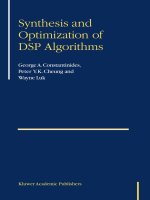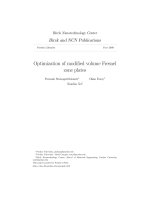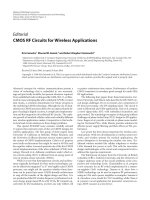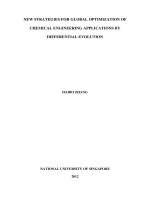parasitic-aware optimization of cmos rf circuits
Bạn đang xem bản rút gọn của tài liệu. Xem và tải ngay bản đầy đủ của tài liệu tại đây (7.43 MB, 182 trang )
Parasitic-Aware Optimization
of CMOS RF Circuits
This page intentionally left blank
Parasitic-Aware Optimization
of CMOS RF Circuits
David J. Allstot
Kiyong Choi
Jinho Park
University of Washington
by
KLUWER ACADEMIC PUBLISHERS
NEW YORK, BOSTON, DORDRECHT, LONDON, MOSCOW
eBook ISBN: 0-306-48129-4
Print ISBN: 1-4020-7399-2
©2003 Kluwer Academic Publishers
New York, Boston, Dordrecht, London, Moscow
Print ©2003 Kluwer Academic Publishers
All rights reserved
No part of this eBook may be reproduced or transmitted in any form or by any means, electronic,
mechanical, recording, or otherwise, without written consent from the Publisher
Created in the United States of America
Visit Kluwer Online at:
and Kluwer's eBookstore at:
Dordrecht
Dedication
This book is dedicated to
Sarah and Matthew,
To our Lord and Hyun-Ah,
and to Vickie, Kevin, and Emily
This page intentionally left blank
Contents
Dedication
Contributing Authors
Preface
Part I: Background On Parasitic-Aware Optimization
Chapter 1
Introduction
Introduction
Overview of Wireless Transceivers
Outline of The Book
Chapter 2
Modeling of On-Chip Passive and Active Components
Monolithic Inductors
BACKGROUND ON MONOLITHIC INDUCTORS
MONOLITHIC INDUCTOR REALIZATIONS
1.
2.
3.
1.
1.1
1.2
v
xiii
xv
1
3
3
5
7
9
9
9
10
viii
Parasitic-aware optimization of CMOS RF circuits
1.3
1.4
1.5
1.6
1.7
MONOLITHIC INDUCTOR MODELS
EXPRESSIONS FOR THE LUMPED INDUCTOR MODEL
M
ONOLITHIC TRANSFORMERS
M
ONOLITHIC
3-D
STRUCTURES
PARASITIC-AWARE INDUCTOR MODEL
2.
Monolithic Varactors
2.1
2.2
2.3
DIODE VARACTOR
INVERSION-MODE
MOS
VARACTORS
ACCUMULATION-MODE
MOSFET
3.
MOS Transistors
3.1
3.2
MOS TRANSISTOR HIGH FREQUENCY MODEL
NOISE MODEL OF MOS TRANSISTOR
Chapter 3
Parasitic-Aware Optimization
1.
Gradient Decent Optimization
2.
Simulated Annealing
3.
Simulated Annealing with Tunneling Process
3.1
3.2
3.3
3.4
TUNNELING PROCESS
LOCAL OPTIMIZATION ALGORITHM
ADAPTIVE TEMP COEFFICIENT DETERMINATION
COMPARISON BETWEEN SA AND ASAT
4.
Genetic Algorithm (GA)
5.
Particle Swarm Optimization (PSO)
5.1
5.2
5.3
P
ARTICLE SWARM OPTIMIZATION ALGORITHM THEORY
OPTIMIZATION PROCEDURE
OPTIMIZATION PARAMETERS
6.
Post PVT Variation Optimization
Part II: Optimization of CMOS RF Circuits
11
13
15
18
20
24
24
25
30
31
31
34
39
40
41
44
44
47
49
50
52
55
55
59
60
62
65
Parasitic-aware optimization of CMOS RF circuits
Chapter 4
Optimization of CMOS Low Noise Amplifiers
1.
Low Noise Amplifier
1.1
NOISE
Thermal noise
1.1.1
1.1.2
Noise figure
1.2
LINEARITY
1.2.1
1.2.2
1dB gain compression point
Two-tone test (IIP2 and IIP3)
2.
Design of Low Noise Amplifier
3.
Optimization of Low Noise Amplifiers
3.1
3.2
3.3
3.4
3.5
3.6
CALCULATING GATE INDUCED NOISE IN
SPICE
CALCULATING NOISE FIGURE IN SPICE
SAVING OPTIMIZATION TIME
COST FUNCTION
PARAMETERS TO BE OPTIMIZED
OPTIMIZATION SIMULATION RESULT
Chapter 5
Optimization of CMOS Mixers
1.
Mixer
2.
Single Balanced Mixer
2.1
2.2
C
ONVERSION GAIN
LINEARITY
2.2.1
2.2.2
IIP3
Calculating IIP3 and conversion power gain
2.3
NOISE FIGURE
2.3.1
2.3.2
DSB and SSB
PSS simulation
2.4
LO LEAKAGE
3.
Double Balanced Mixer
4.
Design of Mixers
5.
Optimization of Mixers
5.1
5.2
C
OST FUNCTION
P
ARAMETER TO BE OPTIMIZED
ix
67
67
67
67
69
70
70
72
76
80
80
81
82
84
84
84
89
89
90
91
92
92
93
95
95
96
96
97
98
99
99
100
Parasitic-aware optimization of CMOS RF circuits
x
5.3
OPTIMIZATION SIMULATION RESULTS
Chapter 6
Optimization of CMOS Oscillators
1.
CMOS Oscillators
2.
Phase Noise
2.1
2.2
2.3
EFFECTS OF PHASE NOISE
LEESON PHASE NOISE MODEL
HAJIMIRI PHASE NOISE MODEL
3.
Design of VCO
4.
Optimization of CMOS VCO
4.1
4.2
OPTIMIZATION OF VCO
OPTIMIZATION RESULTS
Chapter 7
Optimization of CMOS RF Power Amplifiers
1.
RF Power Amplifiers
1.1
LINEAR AMPLIFIER: CLASS-A, B, AB, AND C
1.1.1
1.1.2
1.1.3
Class-A Power Amplifier
Class-B Amplifier
Class-C Amplifier and Class-AB Amplifier
1.2
NONLINEAR POWER AMPLIFIERS: CLASS-F AND CLASS-E
1.2.1
1.2.2
Class-F PA
Class-E PA
2.
Design of Power Amplifier
3.
Optimization of Power Amplifier
4.
POST PVT Optimization
Chapter 8
Optimization of Ultra-Wideband Amplifiers
1.
CMOS Ultra-Wideband Amplifiers
100
105
106
109
109
111
112
113
115
116
117
123
123
124
124
126
127
131
132
134
137
137
141
145
145
Parasitic-aware optimization of CMOS RF circuits
xi
1.1
1.2
1.3
DISTRIBUTED AMPLIFICATION THEORY
CMOS
DISTRIBUTED AMPLIFIER
E
FFECTS OF LOSS IN
CMOS
DISTRIBUTED AMPLIFIERS
2.
Design of CMOS Ultra-Wideband Amplifier
3.
Optimization of CMOS Ultra-Wideband Amplifier
3.1
3.2
O
PTIMIZATION OF A
CMOS
DISTRIBUTED AMPLIFIER
OPTIMIZATION RESULTS
Index
145
148
149
152
155
156
156
16
1
This page intentionally left blank
Contributing Authors
Kiyong Choi
Jinho Park
David J. Allstot
This page intentionally left blank
Preface
The annual market for wireless devices exceeds tens of billions of dollars
worldwide. As markets expand and evolve, there is an insatiable demand for
greater functionality in smaller form factor devices, seamless compatibility
with various communications standards, longer battery operating lifetimes,
and, of course, lower costs. The confluence of these objectives has motivated
worldwide research on system-on-chip (SOC) or system-in-package (SIP)
solutions wherein the number of off-chip components is relentlessly driven
towards zero. These objectives have in turn motivated the development of
CMOS and BiCMOS technologies that are effective in implementing digital,
analog, radio frequency, and micro-electro-mechanical functions together in
SOC solutions.
In the arena of RF integrated circuit design, efforts are aimed at the
realization of true single-chip radios with few, if any, off-chip components.
Ironically, the on-chip passive components required for RF integration pose
more serious challenges to SOC integration than the active CMOS and BJT
devices. Perhaps this is not surprising since modern digital IC designs are
dominated as much, or more, by interconnect characteristics than by active
device properties. In any event, the co-integration of active and passive
devices in RFIC design represents a serious design problem and an even
more daunting manufacturing challenge. If conventional mixed-signal design
techniques are employed, parasitics associated with passive elements
(resistors, capacitors, inductors, transformers, pads, etc.) and the package
effectively de-tune RF circuits rendering them sub-optimal or virtually
useless. Hence, dealing with parasitics in an effective way as part of the
design process is an essential emerging methodology in modern SOC
xvi
Introduction
design. The parasitic-aware RF circuit synthesis techniques described in this
book effectively address this critical problem.
In conventional mixed-signal design, parasitic resistances and
capacitances are estimated during the design process as they affect design
parameters such as bandwidth, phase margin, slew rate, etc. Circuits such as
opamps are characterized by one-sided requirements on the parasitics. That
is, so long as a parasitic capacitance is below a certain value, for example,
the phase margin specification is met or exceed. Because of these one-side
requirements, the circuits are usually designed making some initial
assumptions about the parasitics and optimized just once manually based on
the parasitics extracted from the layout.
Traditional mixed-signal design practices simply do not work for RF
circuits because of the two-side requirements on their parasitic element
values. To tune an RF amplifier to a specific frequency, for example, a nodal
capacitance can be neither too large nor too small. That is, it must realize a
certain value within a specified tight tolerance. This means that the parasitics
associated with all passive elements must be accurately modeled as a
function of the element value prior to the synthesis process. For on-chip
spiral inductors, for example, the compact model often includes about 10
parasitic components that are complex functions of frequency and
inductance value. Moreover, since typical RF circuit blocks may employ
tens of passive components, more than 100 passive and parasitic element
values must be included in the design process. Obviously, such complexity
is unwieldy for typical hand calculations scribbled on the back of a cocktail
napkin. Hence, fast and aggressive optimization tools must be readily
available to assist the designer in meeting specifications with robustness and
cost-effectiveness.
Chapter 1 introduces basic wireless RF transceiver circuits that are
amenable to the parastic-aware circuit synthesis paradigm. Chapter 2
provides an overview of the various passive components used in RF circuit
design and techniques for creating compact parametric models that are
computationally efficient when used in the parasitic-aware optimization
loop. Possible optimization strategies for parasitic-aware synthesis are
presented in Chapter 3 including the classical gradient decent, simulated
annealing, and genetic algorithms. Since parasitic-aware synthesis currently
requires hours or days of computer time even for relatively simple circuits,
efficiency in the optimization algorithms in reducing the required number of
interations is of paramount importance. Hence, new optimization strategies
including tunneling and adaptive temperature coefficient heuristics for use
with simulated annealing are presented along with an exciting and
interesting particle-swarm methodology that finds its first use in circuit
synthesis in this book. Part II of the book provides background on many of
Introduction
xvii
the key RF circuit blocks and focuses on their parasitic-aware synthesis.
Specifically, Chapters 4 through 8 cover low-noise amplifiers, up- and
down-conversion mixers, voltage-controlled oscillators, power amplifiers,
and wideband distributed amplifiers, respectively.
We first developed the proposed parasitic-aware design methodology in
1995 in conjunction with Brian Ballweber and Dr. Ravi Gupta. Since then,
our students and colleagues have improved the design paradigm greatly and
applied it to many interesting and exciting circuits. This book reflects a
small part of that experience. We are especially thankful to Adam Chu for
writing most of Chapter 2, and to our current graduate students for their
contributions: Sankaran Aniruddhan, Sherjiun Fang, Taeik Kim, Srinivas
Kodali, Waisiu Law, Seetaur Lee, Xiaoyong Li, Kristen Naegle, Dicle Ozis,
Jeyanandh Paramesh, Charles Peach, Brian Ward, and Hossein Zarei.
We are pleased to acknowledge support for the research work described
herein from the following sources: DARPA NeoCAD Program under grant
N66001-01-8919; Semiconductor Research Corporation grants 2000-HJ-771
and 2001-HJ-926; National Science Foundation contracts CCR-0086032 and
CCR-01200255 and MRI-0116281, and grants from the National Science
Foundation Center for the Design of Analog-Digital Integrated Circuits,
Texas Instruments, National Semiconductor, and Intel Corporation.
This page intentionally left blank
PART I: BACKGROUND ON PARASITIC-
AWARE OPTIMIZATION
This page intentionally left blank
Chapter 1
INTRODUCTION
1.
In the near future, people’s daily activities will be dominated with
portable wireless devices. To make compact and energy efficient mobile
communicating equipment such as mobile phones, wireless modems, two-
way radios, etc., integrated circuit technology (IC) is necessary because it
not only reduces the size, weight, and power consumption of such devices, it
enables manufacturers to include greater functionality at lower costs. Figure
1-1 shows a general system-on-chip (SOC) solution that comprises digital,
analog, micro-electro-mechanical systems (MEMS), and radio frequency
(RF) circuit blocks. By implementing a sensor in conjunction with an RF
front end, the SOC can receive or transmit data from external sources. The
digital circuitry on the chip consists of CPU, DSP, and memory blocks, and
is used for data processing. Analog-to-digital converters (ADC) and digital-
to-analog converters (DAC) enable the communication of information
between the digital and analog circuits.
It was not long ago that all RF circuits were implemented using gallium
arsenide (GaAs) or bipolar junction transistor (BJT) technologies. CMOS
technology was not viable due to its low values of breakdown voltage,
small-signal transconductance, and unity current gain frequency
Moreover, the lossy silicon substrates contributed a plethora of parasitic
elements to the monolithic passive components that made CMOS inferior to
its bipolar and GaAs counterparts.
However, because CMOS has dominated the world of digital ICs for
more than a quarter century and has achieved a very high level of integration,
INTRODUCTION
4
Introduction
it has become an extremely compelling and cost effective option for use in
SOC design [1],[2]. It has been shown that mixed-signal functions such as
ADCs are effectively designed in CMOS [3],[4]. But despite a large number
of books and other publications [5]-[7], critical RF circuitry such as low-
noise amplifiers (LNA), up- and down-conversion mixers, voltage-
controlled oscillators (VCO), power amplifiers (PA), and wide-band
amplifiers still pose difficult challenges to circuit designers. Alternative
solutions such as multi-chip modules and System-in-Package (SIP) solutions
along with the use of the traditional GaAs technology are difficult to
implement or expensive. Thus, in order to exploit CMOS as the technology
solution for high-volume SOC design and manufacture, the inferior nature of
the technology, especially with respect to parasitic elements, needs to be
overcome. Our experience over the past several years has shown that one
way to achieve high performance designs with robust manufacturing
characteristics vis-a-vis process, temperature, and voltage variations is to
perform global optimization of CMOS RF integrated circuits by including
all device and package parasitics
as
part of the design process.
Introduction
5
2.
OVERVIEW OF WIRELESS TRANSCEIVERS
When it comes to wireless communications, there are many system
standards to support myriad applications. For example, both analog and
digital modulation schemes have been implemented at various RF
frequencies. Amplitude modulation (AM) and frequency modulation (FM)
are examples of analog modulation methods. Digital modulation techniques
are categorized as either linear or nonlinear. Binary Phase-Shift Keying
(BPSK), Quadrature Phase-Shift Keying (QPSK), Amplitude Shift Keying
(ASK), 16-ary Quadrature Amplitude Modulation (16QAM), 9-state
Quadrature Partial Response (9QPR), etc., are examples of the former, while
Minimum Shift Keying (MSK), Gaussian Minimum Shift Keying (GMSK)
and Frequency Shift Keying (FSK) are examples of the latter. The wide
variety of standards also imposes a number of RF front-end circuit
requirements. For example, if the modulation frequency of the system is 900
MHz, the front-end circuits need to be tuned through the use of passive
components to 900 MHz; if the system uses a linear digital modulation
scheme, a highly linear front-end RF circuit is required, and so on.
Figure 1-2 shows a basic RF front-end homodyne transceiver that
operates directly between RF and baseband frequencies. On-chip
implementations include low-noise amplifier (LNA), mixer, and power
amplifier (PA) building blocks; critical off-chip components usually include
a duplexer, and various band-select, image-reject, and channel-select filters.
The off-chip duplexer is used to switch the external antenna between
transmit and receive paths of the transceiver. Important specifications of the
duplexer are isolation between transmit and receive paths as well as its
switching loss which adds directly to the overall noise performance of the
transceiver system.
The main purpose of the LNA in the receive path is to provide sufficient
gain for the RF signal to overcome the noise of subsequent stages of the
receiver. In addition, its gain must be low enough to accommodate the very
wide dynamic range of the input signal without saturating the LNA. Usually,
the noise of the LNA dominates the noise performance of the on-chip
portion of the receiver system.
The down-conversion mixer in the receive path of the homodyne receiver
of Fig. 1.2 is used to directly translate the RF input signal to the baseband
frequency, while the up-conversion mixer in the transmit path performs the
opposite function. In heterodyne architectures, a first down-conversion
mixer in the receive channel converts the RF frequency to an intermediate
frequency (IF) and a second down-conversion mixer converts from IF to
baseband, while two up-conversion mixers perform the opposite functions in
the transmit channel.









